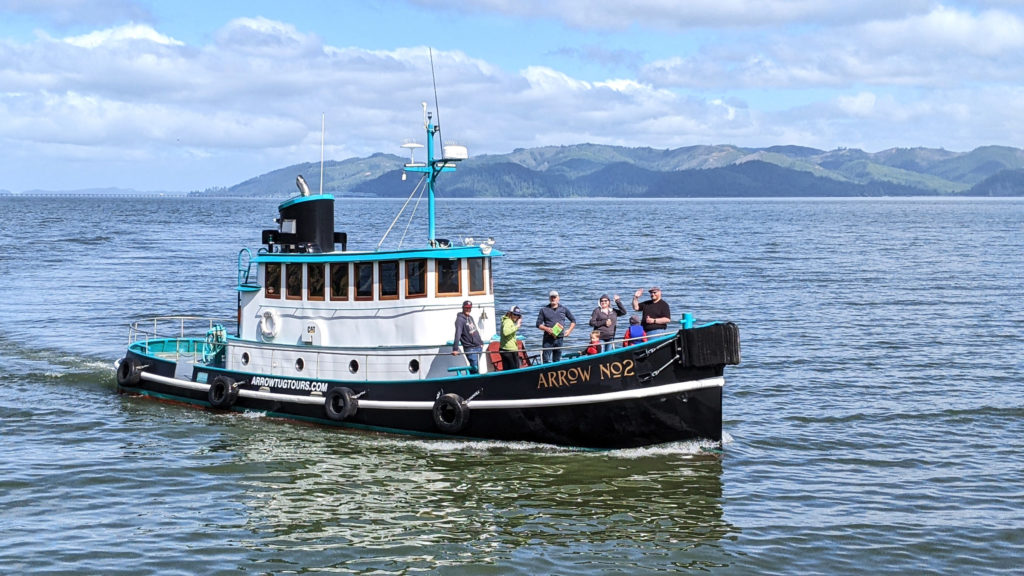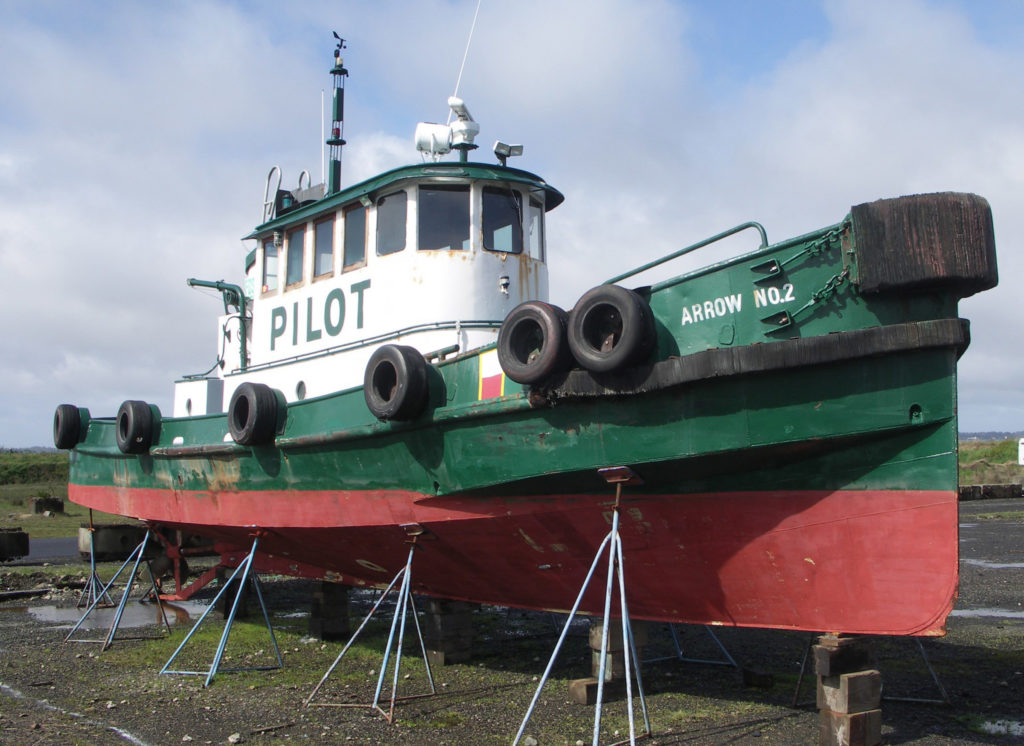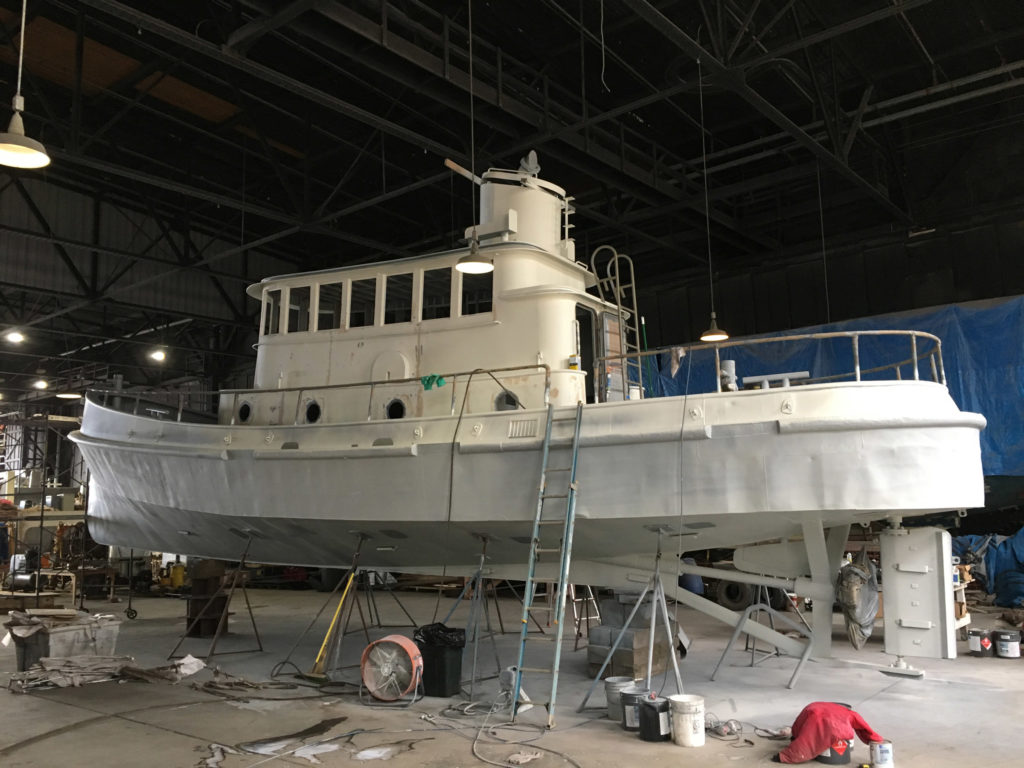
Launched in 1962, the pilot boat Arrow 2 spent 50 years on the Astoria waterfront ferrying pilots between the ships and the shore, day or night, rain or shine. For many years, this hard-working commercial boat and her crew performed their task almost unnoticed by the townspeople, but by 2000, together they had become a favorite sight for locals and visitors from all over the country. Unfortunately, the boat’s age and traditional design caught up with it in 2012, when she was retired and disappeared for nearly a decade. Its many admirers were left to wonder what had become of it: Would the old boat become a back-up for the new boat or rust away on some backwater? Many former crewmembers talked about restoring the old Arrow 2, but local resident Mark Schacher, who had worked on the river since he was 14 years old, was the one who finally made an offer and took on the responsibility of restoring this part of Astoria’s maritime heritage.
It was 2016 before he was able to haul the boat out on the WWII-era seaplane ramp located at the Tongue Point shipyard at the east end of the city, hoping to have it back in good running order in a couple of years. After all, it was a steel workboat not a varnished wooden yacht, and he was not about to change the exterior appearance with its visible dents and welds acquired while coming alongside thousands of ships. A year later, the boat went back into the water and was driven to its new berth in Warrenton, six miles downriver. The succeeding years slipped by as Mark attempted to complete the overhaul of the engine room and upgrade the pilothouse to carry paying guests, never doubting that he could transform Arrow 2 into a charter tour vessel. By the time I sat down to interview him for this story, he had spent another five years dedicated to the restoration and return of Arrow 2.

ORIGIN STORY
But before I dive into that saga, let’s travel back in time to 1962—the year the Space Needle opened in Seattle and the Beatles released their first record.
The then-new Arrow 2 replaced a wooden boat of the same name and went straight to work without any ceremony on a routine of trips to passing ships that were never more than a mile away. Now, this looked very easy to anyone watching from the shore because they could barely see what happened when the boat came alongside the ship right under its ladder. The boarding pilot then would quickly grab a hand rope and step or leap onto the nearest rung, while the ship proceeded at a speed of 10 knots to maintain steerage. This was the pilot’s daily challengeto reach their worksite and where the boat’s skipper earned their respect. For the few minutes they were on the Arrow 2, the pilots had no time or need for comfort. The seats in the small pilot house were a pair of hard wooden benches and there was no head. The pilots actually had little or no say in the layout of the boat because the pilot-transfer service in the river was—and still is—owned and operated by a tugboat company. For many years, this had been Arrow Launch, which had been operating small tugs since the early 1900s. Arrow Launchowner Jim Stacy had built up a fleet of five wooden craft all named Arrow plus a hull number from 1 to 5. Between 1940 and 1960 he replaced his four tugs at George Nichols boatyard in Hood River in the Columbia Gorge. By 1958, he had transferred their names and numbers to the new steel hulls, leaving the old Arrow 2, built in Astoria in 1907, as the last of his wooden boats. In 1960, its steel replacement was also under construction in Hood River, where the yard was busy building grain barges and big push tugs.Stacy wanted the new pilot launch to look and perform as well as the original Arrow 2 and with a lifetime of experience, he knew what he wanted. Like most traditional operators, he simply drew up a rough set of drawings and relied on Nichols to fill in the details. The result was a long lean hull with 50’ of waterline and a narrow 14’ beam. The aft deck was low, rising to a high bow protected by heavy rubber fendering. Stacy employed two craftsmen to maintain and repair his small fleet—Ed Prebish, welder and mechanic, and Bill Maki, carpenter. They had insisted on full headroom in the engine room, so Stacy added a raised deck area amidships about 30” high to his drawings. Nichols launched the bare hull into the dredged cove now called Nichols Boat Basin, and an Arrow tug towed it out into the mighty Columbia and downstream to the Bonneville Dam locks. From here, it was 140 miles to Astoria, where the crew moored the new boat at the 14th Street dock. The fitting out began with the installation of a new Cummins V-8 200hp diesel engine and a heavy-duty German Reintjes reduction gear, 4.5” driveshaft, and big 48” propeller. That was followed by the pilot house, which was fabricated in the Arrow workshop also on 14th Street.The visible feature of the house was the 15 wooden-framed windows that gave the pilot and helmsman a full view and permitted ventilation on warm days. All the deck fittings were oversize such as the sturdy tow post. The crews quickly learned to handle the new boat alongside ships of all types and were satisfied with the boat, which ran at an economical speed of 8 knots, but the shallow-V hull could easily reach 10 knots without much of a wake. (Ironically, Stacy only had a year to appreciate Arrow 2; in 1962, he sold the pilots’ contract, the dock, and the boat to the Knappton Towboat Co.)
However, I doubt any of them would have bet on it still working 50 years later, let alone being admired and photographed by thousands of visitors. At that time, the annual total of ships calling on the Columbia was over 2,000, requiring more than 4,000 trips for the pilots per year. They came to load the wheat and other crops that arrived by rail from distant prairie states or by truck and barge from the inland empire.
By the 1980s, the idea of shipping goods in containers was starting to take hold, and typical bulk cargo ships had reached “Panamax” size of 950’ by 106’—the limit of the Panama Canal locks. The annual calls dropped below 2,000, but since they could now carry up to 80,000 tons of cargo, the total tonnage increased, and the Columbia remained the biggest export outlet of wheat in the world. Alongside those giants, the Arrow 2 faithfully ran like clockwork every day, playing its part in the international trade.
By 2000, the Columbia Bar Pilots had improved their service with the first of two 70’ high-speed aluminum launches designed by Camarc of Scotland. They could cross the bar and cover the 12 miles to their boarding point on the Pacific in half an hour in good conditions. The bar pilots also introduced the option of flying out by helicopter when visibility was good, which would have had the old-time captains turning in their graves! By then, I was driving to Astoria every year researching stories and was offered rides on both the old and new pilot boats for an article that appeared in Northwest Yachting. Soon after, I found myself setting up my office in Astoria in a small low-rent apartment on 12th Street. The front door was just a few steps from the pilots’ dock, and in case you haven’t already guessed, I too became a member of the Arrow 2 fan club. For the next ten years, I checked to see if the boat was in sight every time I stepped out.
In 2008, during its annual overhaul, the Arrow 2 was repowered with its fourth engine, a Caterpillar C-18 putting out 700-horsepower. This was far more than it needed, but promised a long life. It also seemed to show that Foss Maritime, the fourth owner of the pilot contract, would keep the boat going for a few more years. As if to prove its value, the boat made the front page of the Daily Astorian the next year when a single-engine commuter plane crash-landed in the river close to the shore after the turbo-prop quit. Despite its total lack of modern electronics, the Arrow 2 was close enough to beat the Coast Guard high-speed boat to the rescue.
The crew skillfully picked up the pilot Bill Henningsgaard, a former Microsoft executive and a well-known Seattle philanthropist, and his mother Edith, 84, a former mayor of Astoria, both standing on the submerged wing with water up to their knees. The wreckage of the plane was hoisted onto the dock a day later, and the Arrow 2 won more fans. But that didn’t count with Foss, which soon announced they would be replacing it with another modern Camarc pilot boat.
When the last day for the Arrow 2 arrived, the Daily Astorian published a farewell story and announced that by their calculations it had made at least 250,000 round trips.

RESTORATION WORK
This achievement certainly left its mark, as Mark found after he removed the sponsons added to the bow. This improved its appearance, yet revealed the poor state of the original hull plate underneath! Next step was to remove the pilot house, revealing more corrosion on the aft deck. Sandblasting the rest of the hull removed many layers of paint and uncovered more corrosion around the stem. Then came the slow process of making patterns and shaping a new plate to be welded into the cutaways by Mark with the assistance of a friend and crewman on the new pilot boat, Drake Fischer.
I stopped by occasionally, but kept out of the way until April of 2017 when I watched the Arrow 2 relaunching and took the first photos of the 55-year-old boat back in her element. The new longer house looked good—and no longer displayed “PILOT” in large letters on the side. Mark planned to continue the overhaul to pass the Coast Guard survey to carry six passengers (the six-pack rule) but there were many problems to be resolved between old and new equipment. By the time 2020 arrived, the boat was finally emerging from its retirement and looked ready to go—until the pandemic struck. The only positive was more time for the skipper to finish his paperwork. He already had a 100-ton USCG license, but still needed the Oregon state marine guide license, insurance policy, website and flyers, so his tours didn’t really get going until 2022, when I saw him proceeding along the waterfront and realized it was time to catch up and hear the whole story.
I found the boat in Warrenton, and was invited straight into the engine room where Mark had spent so much time. “When I bought it, I knew the boat really had no value—except for the motor, which was in very good shape with only 7,500 hours,” he explained. First came a full overhaul on the engine including machining the cylinder head and inspecting all bearings, pumps, etc. Many systems needed replacing including the cabin’s heater, pumps, switches and wiring, plus the plumbing and tank for the new bathroom at the aft end of the house. The result is a very clean space with everything clearly marked and accessible.
In the pilot house, I was amazed at the transformation. Mark had insulated and paneled the walls and put up a large video screen to play a program on local history—and the bench seats finally had some padding. The 15 original window frames, each one a unique shape, had to be recreated in hardwood, plus two more for the extension, all cut to within a degree to fit properly. Reflecting on the time it took, he agreed it might well have been easier to build a copy rather than restore the original vessel to a seaworthy state—as is often the case. But, as we all know, it is the history of old boats that attracts fans and customers.
BACK TO THE FUTURE
“The Arrow 2 is kind of a working museum now and I want all my passengers to share my affection for the boat and discover there is nothing like discovering the historic sites from the water,” he told me proudly. In the year he has been running tours, he has had some memorable customers including several groups from Europe who appreciated the historical aspects of the region.
For those tours, Arrow 2 now heads upriver from Warrenton, crossing the mouth of the Youngs River to Smith Point and the Port of Astoria docks before passing under the impressive 4-mile long Astoria-Megler bridge. The Astoria waterfront is spread over two miles and includes several old canneries and warehouses that survived the great fire of 1922 and are now converted to breweries, restaurants and hotels. At the east end is Pier 39, famous as the home of the Bumble brand and now the site of a cannery museum, canvas shop, and many other attractions. The Arrow 2’s journey continues around the cliffs of Tongue Point, out of the main channel, and back in time to a WWII Naval Air Station with a ramp and hangars to house PBY Catalina seaplanes. Hundreds of ships were mothballed here after the war, and it is now the site of a busy shipyard where tugs and fishing vessels are hauled out and serviced.
“We have seen everything from whales, sea lions, and river otters to pilot transfers,” he recalls with satisfaction.
It did all lead me to the inevitable question: How much has this “labor of love” actually cost? Mark estimates that to hire professionals would have cost at least $500,000. That sounds like a lot for a restored steel workboat, I pointed out. He agreed, but reminded me that with the Arrow 2 now in first-class shape, it is able to work for its keep and begin paying him back. I think we can all agree that is only fair.
>> For more information on Arrow 2, or to book an experience or tour aboard, visit: arrowtug.com.